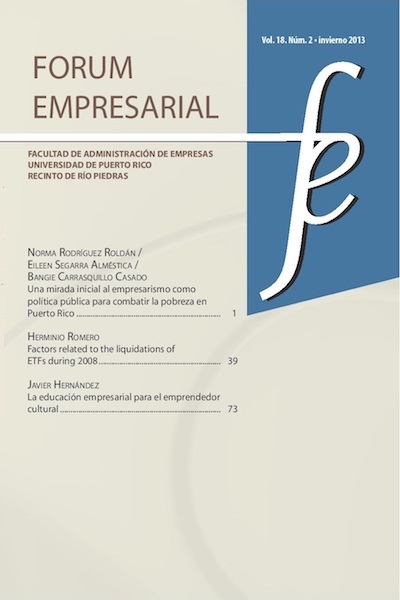Abstract
The purpose of this study is to identify factors related to the closing of 50 ETFs in 2008. The study compared the sample of liquidated ETFs to a matched sample of active ETFs. The factors used as explanatory variables were: market capitalization, liquidity, ETF return, Index return, tracking error, fund age, and premium. Lower liquidity values, higher tracking errors, and higher ETF returns were associated with higher probabilities of liquidation. The researcher found evidence that ETFs‘ market makers were profiting from the creation of new ETFs‘ shares just before liquidating the ETFs‘ shares at a premium.References
Ackert, L.F., & Tian, Y.S. (2000). Arbitrage and Valuation in the Market for Standard and Poor‘s Depositary Receipts. Financial Management, 29(3), 71-87.
Baquero, G., Ter Horst, J., & Verbeek, M. (2005). Survival, Look-Ahead Bias, and Persistence in Hedge Fund Performance. Journal of Financial and Quantitative Analysis, 40(3), 493-517.
Boney, V., Doran, J.S., & Peterson, D.R. (2007). The Effect of the Spider Exchange Traded Fund on the Cash Flow of Funds of S&P Index Mutual Funds. Institutional Investors Guide to ETFs, 41(10), 61-74.
Chen, H.L., Gao, S., & Hu, X. (2012). Closing and Cloning in Mutual Funds. Journal of Banking & Finance, 36(4),1210–1223.
Demaine, J. (2002). Exchange traded funds for the sophisticated investor. Derivatives use, Trading and Regulation, 7(4), 354-361.
Dukes, W.P., English II, P.C., & Davis, S.M. (2006). Mutual Fund Mortality, 12B-1 Fees, and the Net Expense Ratio. The Journal of Financial Research, 29(2), 235-252.
Elton, E.J., Gruber, M.J., Comer, G., & Li, K. (2002). Spiders: Where are the bugs? Journal of Business, 75(3), 453-472.
Gastineau, G.L. (2004). The Benchmark Index ETF Performance Problem. The Journal of Portfolio Management, 30(2), 96-103.
Getmansky, M., Lo, A.W., & Mei, S.X. (2004). Sifting Through the Wreckage: Lessons from Recent Hedge-Fund Liquidations. Journal of Investment Management, 2(4), 6-38.
Getmansky, M. (2008). The Life Cycle of Hedge Funds: Fund Flows, Size and Performance. Working paper.
Guedj, I., & Huang, J. (2009). Are ETFs Replacing Index Mutual Funds? Working paper.
Gulen, H., Bris, A., Rau, R., & Kadiyala, P. (2007). Good Stewards, Cheap Talkers, or Family Men? The Impact of Mutual Fund Closures on Fund Managers, Flows, Fees, and Performance. Review of Financial Studies, 20(3), 953-982.
Kostovetsky, L. (2003). Index Mutual Funds and Exchange-Traded Funds. The Journal of Portfolio Management, Summer, 80-92.
Lin, V., & Mackintosh, P. (2010). ETF Mythbuster: Tracking Down the Truth. The Journal of Index Investing, Summer, 95-106.
Madura, J., & Ngo, T. (2008). Pricing behavior of exchange-traded funds. Journal of Economics and Finance, 32, 1–23.
Manakyan, H., & Liano, K. (1997). Performance of mutual funds before and after closing to new investors. Financial Services Review, 6, 257-269.
Mussavian, M., & Hirsch, J. (2002). European Exchange-Traded Funds: An Overview. The Journal of Alternative Investments, Fall, 63-77.
Poterba, J.M., & Shoven, J.B. (2002). Exchange-Traded Funds: A New Investment Option for Taxable Investors. The American Economic Review, 92 (2), 422-427.
Rodriguez, J., & Romero-Perez, H. (2012). A look at side by side management: evidence from ETF and mutual funds. Quantitative Finance, 12(11), 1637-1645.
Smaby, T.R., & Fizel, J.L. (1995). Fund closings as a signal to investors: Investment performance of open-end mutual funds that close to new shareholders. Financial Services Review, 4, 71-80.
Ter Horst, J., & Verbeek, M. (2007). Fund Liquidation, Self-selection, and Look-ahead Bias in the Hedge Fund Industry. Review of Finance, 11, 605-632.
Zhao, X. (2004). Why are some mutual funds closed to new investors? Journal of Banking & Finance, 28, 1867-1887.
Zhao, X. (2005). Exit Decisions in the U.S. Mutual Fund Industry. Journal of Business, 78(4), 1365-1401.
By submitting a contribution to consideration of the Editorial Board of Fórum Empresarial, the authors attest that it is an original, unpublished work, which has not been nor will be simultaneously submitted to another journal for consideration and publication; that they are responsible for the work carried out and the content of the article; and they have the corresponding copyrights.
The authors grant the right of first publication of their work to Fórum Empresarial, in any medium and physical and electronic format, including internet. Publication shall be subject to the Creative Commons Attribution-NonCommercial 4.0 International License, which allows third parties to share the work, provided that the author and Fórum Empresarial (as a first publication) are cited.
The journal allows authors to retain publishing rights without restrictions. Authors are able to enter into separate, additional arrangements for the non-exclusive distribution of the journal's published version of the work (e.g., post it to an institutional repository or publish it in a book), with an acknowledgment of its initial publication in Fórum Empresarial.

